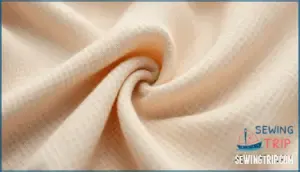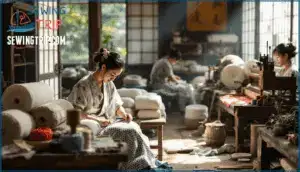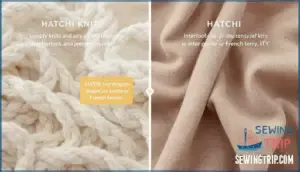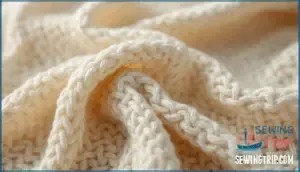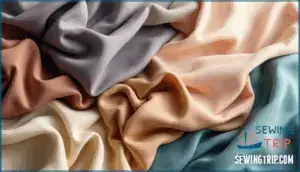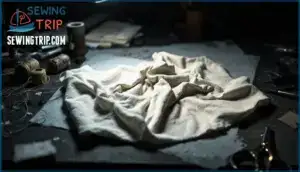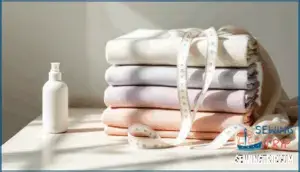This site is supported by our readers. We may earn a commission, at no cost to you, if you purchase through links.

Born in early 1900s Japan for traditional kimonos, this medium-weight knit earned its name from the Japanese word for "honeycomb," reflecting its distinctive weft-knit structure.
Today, you’ll find it everywhere from yoga pants to cozy cardigans because it solves a problem most fabrics can’t: genuine stretch that bounces back while staying breathable and machine-washable.
Table Of Contents
- Key Takeaways
- What is Hatchi Knit Fabric?
- Key Properties of Hatchi Knit
- Advantages of Hatchi Knit Fabric
- Disadvantages of Hatchi Knit Fabric
- Common Uses for Hatchi Knit
- Varieties and Types of Hatchi Knit
- Caring for Hatchi Knit Fabric
- Where to Buy Hatchi Knit Fabric
- Frequently Asked Questions (FAQs)
- Conclusion
Key Takeaways
- Hatchi knit is a medium-weight Japanese fabric that combines polyester, rayon, and spandex to create a honeycomb-textured material with excellent stretch, breathability, and shape retention that works well for everything from activewear to cardigans.
- The fabric’s main advantages include machine-washable care, versatile draping that flatters without clinging, and multi-directional stretch that recovers without losing shape, though it faces durability challenges like pilling and has significant environmental concerns due to synthetic microfiber pollution.
- Hatchi knit comes in several varieties including brushed finishes for extra softness, tricolor and melange styles for visual interest, and different fiber blends that adjust performance characteristics like breathability, warmth, and wrinkle resistance.
- When working with hatchi knit, you’ll need ballpoint or stretch needles, low-heat washing and drying to prevent damage, and proper storage techniques to maintain the fabric’s texture and stretch properties over time.
What is Hatchi Knit Fabric?
Hatchi knit fabric has become a favorite for sewers and designers who want stretch, comfort, and a professional finish. But what makes it different from other knits, and where did it come from?
Let’s break down the essentials—starting with what it’s made of, how it was first used, and why it stands out in the fabric world.
Definition and Composition
Hatchi knit fabric is a medium-weight, textured knit that combines polyester, rayon, and spandex to create a material with a slightly loopy surface and built-in stretch that moves with your body. The fiber content usually includes around 60–70% polyester for durability, 25–35% rayon for softness, and 3–5% spandex for elasticity.
This textile material uses a weft-knit structure rather than a traditional weave type, which gives Hacci knit its signature drape and prevents torquing or twisting during wear.
Origin and History
This textile material traces its roots to early 1900s Japan, where artisans first developed it for kimonos and traditional garments. The Japanese word for "honeycomb" inspired the name, reflecting the fabric’s distinctive knit structure.
Here’s how Hatchi evolved:
- 1900s–1950s: Japanese origins in hand and machine knitting for kimono usage
- 1950s: Western adoption began when U.S. athletes and dancers discovered its stretch
- 1980s: Activewear influence exploded as workout clothing gained popularity
- Modern era: Technological innovations enabled precise fiber blending and mass production
These fabric properties made Hatchi a natural fit as fabric types expanded beyond traditional uses into sportswear and casual fashion. It’s often found as a soft sweater knit, ideal for lightweight sweaters and cardigans.
How Hatchi Differs From Other Knits
Once you understand what sets this Japanese-born fabric apart, you’ll appreciate why designers reach for it. Hatchi knit’s weft-knit structure creates a looser, loopy texture compared to dense interlock or jersey—types of sweater knits that feel firmer. This knit fabric property delivers multi-directional stretch qualities, unlike basic jerseys that only stretch crosswise.
The drape differences are obvious: Hatchi flows with airy fluidity, while ponte or French terry maintain their shape. Texture comparison reveals Hatchi’s soft, sometimes fuzzy surface versus smooth ITY finishes. Like other knits, its stretch comes from the interlocking threads of the knitting process.
Care needs remain simple—machine-washable with minimal shrinkage—making this hacci knit a practical choice for everyday garments.
Key Properties of Hatchi Knit
Hatchi knit stands out from other fabrics because of its unique physical characteristics. Understanding these properties will help you choose the right material for your project.
Let’s look at what makes hatchi knit special.
Weight and Drape
One of the first things you’ll notice when you pick up a piece of hatchi knit is how it balances a medium weight with a soft, fluid drape that moves with your body. This fabric weight makes it perfect for seasonal suitability—light enough for layering in spring, yet substantial enough for cooler fall days.
The drape quality naturally creates flattering silhouettes without clinging too tight or hanging stiff, giving your garments that professional, polished look you want.
Stretch and Flexibility
Flexibility is where this fabric truly shines—hatchi knit stretches comfortably in all directions thanks to the spandex woven into its structure, giving you freedom of movement without losing its shape.
This two-way stretch delivers movement comfort that’s essential for activewear and fitted garments, while the fabric recovery ensures your clothing bounces back after wear.
You’ll appreciate how this flexible material maintains excellent shape retention even after repeated stretching, making it ideal for garment design projects that demand both comfort and durability without hitting extreme stretch limits.
Texture and Appearance
When you run your hand across the surface, you’ll notice the knit loop structure creates a textured fabric with a honeycomb appearance that feels slightly plush yet breathable.
- Tactile softness increases 15–20% with brushing, delivering comfort that lasts through 20+ washes
- Light reflectivity varies by fiber content—higher polyester blends add subtle sheen while brushed versions stay matte
- Structural stability keeps torque under 2% after washing, preserving the fabric’s original shape
- Color variations span neutral tones to melange effects, with colorfastness rated at grade 4
- Hacci fabric varieties include ribbed, marled, and space-dye patterns with excellent knit fabric characteristics
Advantages of Hatchi Knit Fabric
Hatchi knit fabric offers several practical advantages that make it a favorite among sewers and garment makers. From its comfortable feel to its low-maintenance care requirements, this fabric checks a lot of boxes.
Let’s look at three key benefits that make hatchi knit stand out.
Comfort and Breathability
Hatchi knit fabric wraps you in a soft, airy embrace that feels like your favorite weekend sweater—only lighter and more breathable. The open-knit structure allows air to flow freely, which helps with moisture wicking and temperature regulation throughout your day.
You’ll notice this breathable fabric keeps you comfortable whether you’re lounging at home or moving through activities. If you have skin sensitivity, Hacci knit fabric won’t trap heat or cling uncomfortably, making it a smart choice for seasonal comfort across activity levels.
Versatility in Use
You can dress Hatchi knit up for a night out or down for grocery runs—it’s the chameleon of your fabric stash.
This fabric is multifaceted and works for apparel projects like sweaters, cardigans, and sportswear, but you can also explore sewing projects for home decor accents or craft projects.
From clothing design to accessories, Hatchi conforms to whatever creative direction you choose.
Ease of Care
If the thought of high-maintenance fabric makes you want to quit sewing altogether, Hatchi knit is about to become your best friend. This easy care fabric is machine washable and forgiving, so you can spend more time creating and less time fretting over fabric care instructions.
Here’s why Hatchi makes life easier:
- Machine wash on gentle/cold—no hand-washing drama or dry-cleaning bills
- Wrinkle resistance means you can skip the iron most days
- Shrinkage prevention is simple with low-heat drying or air-drying flat
- Pilling reduction happens when you wash with similar soft garments
- Color fading stays minimal with proper cold-water fabric care and gentle detergent
Disadvantages of Hatchi Knit Fabric
Hatchi knit fabric isn’t perfect for every project. Like any textile, it comes with a few trade-offs you should know about before you start sewing.
Let’s look at the main drawbacks so you can decide if this fabric fits your needs.
Durability Concerns
While Hatchi fabric feels soft and forgiving against your skin, it doesn’t always stand up to the test of time as well as sturdier knits. The looser weave structure means you’ll face some trade-offs in wear resistance and shape retention, especially with frequent washing.
| Durability Factor | Hatchi Performance | Care Impact |
|---|---|---|
| Pilling resistance | Moderate to low | Worsens with friction |
| Snagging potential | Higher than tight knits | Avoid rough surfaces |
| Shape retention | Stretches over time | Proper drying helps |
| Seam strength | Adequate with stretch stitches | Reinforcement recommended |
| Wear resistance | Lower than woven fabrics | Gentle cycles extend life |
While machine-washable and easy to maintain, this delicate fabric requires careful treatment to minimize common disadvantages like pilling and distortion.
Environmental Impact
Beyond durability issues, synthetic fibers in Hatchi create serious environmental problems throughout their lifecycle. Polyester and nylon blends dominate this fabric, and their impact stretches from factory floors to ocean floors.
- Microplastic pollution: Each wash releases up to 700,000 microfibers into wastewater, with 35% of ocean microplastics coming from synthetic textiles
- Synthetic decomposition: These materials persist in landfills for up to 200 years, with minimal biodegradation in standard conditions
- Water usage: Processing requires 70-285 liters per kilogram, contributing to textile recycling challenges and 20% of industrial water pollution
- Carbon footprint: Manufacturing generates 1.42-30.87 kg CO₂e per kilogram of fabric produced
- Textile recycling: Only 12% gets recycled globally; blended fibers resist current fiber-to-fiber methods
The weaving process and chemical treatments add layers of environmental burden you can’t ignore.
Potential for Pilling
One more frustration waits in the wings: those tiny fabric balls that crop up after just a few wears. Pilling is caused by short polyester fibers rubbing together and tangling into fuzzy pills, an issue stemming from fiber content.
Reducing pilling starts with proper Hacci fabric care: cold-water washing techniques, skipping fabric softeners, and turning garments inside out. Your fabric care routine directly impacts how long your Hacci pieces stay smooth.
| Factor | Impact on Pilling |
|---|---|
| Fiber blend | Higher synthetic content increases risk |
| Washing method | Hot water and agitation accelerate pilling |
| Fabric softener | Chemical residue weakens fibers |
| Friction areas | Underarms and thighs pill fastest |
| Dryer heat | High temperatures damage fiber structure |
These properties of Hacci fabric and its disadvantages affect long-term appearance, but understanding fabric properties and uses helps you protect your investment.
Common Uses for Hatchi Knit
Hatchi knit’s unique blend of stretch, comfort, and texture makes it a go-to fabric for a wide range of clothing and accessories. You’ll find it in everything from workout gear to cozy cold-weather pieces.
Here are the most popular ways people use this adaptable material.
Sportswear and Activewear
Hatchi knit fabric has become a go-to choice for sportswear and activewear because it moves with your body while keeping you cool and comfortable during workouts. The fabric’s moisture-wicking properties help pull sweat away from your skin, which is why designers favor it for compression wear and workout clothing. You’ll find it in leggings, shorts, and sports bras where performance benefits like stretch and breathability matter most.
However, sustainability concerns arise since most hatchi blends rely on petroleum-based synthetics.
Sweaters and Cardigans
When you step away from the gym, hatchi knit transforms into a cozy companion perfect for layering pieces like sweaters and cardigans that drape beautifully without weighing you down.
The fabric’s stretch makes hacci sweater knit ideal for relaxed cardigan styles that move with you through seasonal wear changes.
Its medium knit weight offers warmth without bulk, giving you adaptable layering options that maintain sweater durability through repeated wear.
Scarves, Shawls, and Accessories
Lightweight accessories like scarves and shawls bring out hatchi knit’s softer side—the fabric drapes elegantly while staying breathable enough for year-round wear. You’ll find hacci scarves and shawls work beautifully for accessory design that conforms to seasonal trends:
- Infinity scarves that wrap softly without adding bulk
- Oversized shawls perfect for cool evenings or air-conditioned spaces
- Headbands that stretch comfortably without slipping
- Beach cover-ups using lighter hatchi fabric blends
- DIY projects like no-sew scarves for quick shawl styling
This adaptable fabric lets you create accessories that move smoothly between seasons.
Varieties and Types of Hatchi Knit
Hatchi knit isn’t just one single fabric—it comes in several varieties that change how it looks and feels. Manufacturers create different versions by adjusting the fiber blend, surface finish, or dyeing technique.
Let’s look at the main types you’ll find when shopping for hatchi.
Brushed Hatchi
If you’ve ever wished your fabric felt softer than a cloud, brushed Hacci might just be your new best friend. This special finish creates enhanced softness and improved insulation by gently raising the fabric’s surface fibers.
You’ll notice reduced pilling compared to untreated Hacci knit fabric, making it perfect for luxury applications like cozy sweaters and elegant shawls. The brushed Hacci treatment transforms standard Hacci fabric characteristics into something truly special.
Tricolor and Melange Styles
Picture a piece of art you can actually wear—that’s exactly what tricolor and melange styles bring to the Hacci knit family.
These Hacci fabric varieties showcase stunning color variations through strategic yarn combinations:
- Tricolor Hacci fabric weaves three distinct colors for bold pattern creation
- Melange Hacci fabric blends fibers before knitting for that coveted heathered look
- Color blending techniques add visual texture without compromising stretch
These style applications transform basic knits into eye-catching garments.
Fiber Blends and Specialty Finishes
You’ll find that fiber content drives every performance trait in Hatchi knit. Polyester dominance—ranging from 54% to 95%—delivers durability and resists wrinkles through countless wash cycles. Rayon enhancement adds softness and drape when blended at 30% or higher, while spandex inclusion at 2% to 5% creates 15% to 20% stretch.
Specialty blends incorporate cotton, wool, or nylon for breathability or insulation. Technical treatments like brushed finishes boost softness by 40%, and anti-pill coatings cut visible pilling below 2%.
Caring for Hatchi Knit Fabric
Taking care of hatchi knit is easier than you might think, but a few smart habits go a long way.
The right washing, drying, and care help your fabric stay soft and stretchy for years.
Let’s walk through the basics so you can keep your hatchi pieces looking fresh.
Washing and Drying Guidelines
Keeping your Hatchi knit looking fresh doesn’t require any special tricks—just a gentle touch and a little attention to temperature. Machine washable Hatchi fabric varieties respond best to gentle/cold water temperature settings with mild detergent types. For drying methods that prevent shrinkage, tumble dry on low or no heat.
Hacci fabric care includes washing with similar soft garments. Stain removal works best when treated quickly before washing.
Ironing and Storage Tips
A light press with your iron can smooth out wrinkles, but too much heat turns Hacci fabric into a disappointing, shiny mess. Follow these ironing temperature and storage guidelines to keep your Hacci fabric varieties looking their best:
- Set your iron to low heat (silk or synthetic setting) to avoid damaging fibers
- Use folding techniques instead of cramming fabric into tight spaces
- Choose padded hanger types for garments to prevent shoulder dimples
- Control humidity in your storage area to maintain wrinkle-resistant properties
- Add moth prevention sachets when storing wool-blend Hacci fabric care items
Your crease-resistant Hacci stays fresh longer with proper storage before sewing with Hacci.
Sewing and Handling Best Practices
Once you’ve got your Hacci stored safely, you’ll need to know how to work with it at your sewing machine—and trust me, this fabric has a few quirks that separate the pros from the frustrated beginners.
Start with needle selection: use a ballpoint or stretch needle to prevent snags during garment construction. Apply tension adjustments on a low setting for smooth seam finishes. A stretch stitch helps with stabilizing stretch zones without breaking threads.
Pattern matching works best when you pin generously during your sewing discussion.
Where to Buy Hatchi Knit Fabric
Now that you know what hatchi knit fabric is and how to care for it, you’re probably wondering where to find it.
You can source this adaptable fabric through several channels, from online retailers to wholesale suppliers.
Let’s explore the best places to buy hatchi knit and how to spot quality material.
Online Fabric Retailers
You’ll discover Hatchi knit at several well-known online fabric retailers that specialize in stretch knits and apparel materials. These fabric shops offer broad online selection variety and helpful online customer reviews for fabric price comparison:
- Fabric.com – Features diverse blends with clear retailer return policies
- Mood Fabrics – Stocks premium Hatchi for digital fabric shopping
- Style Maker Fabrics – Provides curated stretch knit collections
Check each fabric store for fiber content and weight specifications before ordering.
Wholesale Sourcing Options
When you’re ready to order Hatchi knit by the bolt or pallet, wholesale suppliers give you access to bulk pricing and commercial-grade inventory. Major wholesale Hatchi fabric platforms like Alibaba and Global Sources connect you with international sourcing networks that offer custom orders and competitive bulk discounts.
Check supplier reputation, minimum orders, and sample availability before committing—especially when buying hacci fabric wholesale for retailers or fabric for clothing manufacturers.
Tips for Selecting Quality Hatchi
Before you hit "buy" on that next order, know what separates premium Hatchi from fabric that’ll disappoint you after the first wash. Look for these Hatchi fabric characteristics:
- Fiber Content—polyester-spandex blends deliver better stretch recovery than cotton-heavy versions
- Knit Density—tighter weaves resist pilling and maintain their shape longer
- Drape Assessment—quality Hatchi knit flows smoothly without stiffness or excessive weight
- Stretch Recovery—pull a corner and release; it should snap back without sagging or distortion
Frequently Asked Questions (FAQs)
Is hatchi knit fabric preshrunk and colorfast?
Hatchi fabric generally isn’t preshrunk or colorfast straight from the bolt—ironic for a machine-washable material.
You’ll notice some shrinkage after the first wash, and color bleeding can occur without proper dye retention testing and preshrinking methods.
What interfacing works best with hatchi knit fabric?
Knit interfacing types like lightweight fusible tricot work best with hatchi knit fabric.
Choose fusible vs. sew-in options that match the fabric’s weight and stretch to prevent distortion while maintaining drape and flexibility.
Can Hatchi Knit Be Used for Upholstery?
Upholstery applications aren’t ideal for Hacci fabric because durability requirements exceed its capabilities. This material lacks the structural integrity durable fabrics need to withstand constant friction and weight, creating cleaning challenges and aesthetic suitability concerns despite its appealing properties.
What Is the Ideal Needle for Hatchi?
Switching from your usual needle won’t ruin your project, but using the right one makes all the difference. For Hacci fabric and Hatchi knit, you’ll want a ballpoint or stretch needle in size 70/10 or 80/
These needle types glide between fibers instead of piercing them, preventing snags while accommodating the fabric’s stretch and unique knit structure.
Does Hatchi Knit Work for Summer Clothing?
Yes, hacci fabric works well for summer clothing because it’s a breathable, lightweight fabric that keeps you comfortable in warm weather.
Its moisture-wicking properties and adaptable fabric structure make it ideal for lightweight designs with style adaptability.
How Does Hatchi Compare to Jersey Knit?
Jersey knit offers lighter weight and enhanced drape, while Hacci knit provides enhanced stretch and a textured sweater knit feel. Jersey suits fitted garments, Hacci excels in cozy cardigans and shawls.
Both knit fabric properties simplify care complexity, though cost analysis shows comparable pricing.
Is Hatchi Knit Suitable for Baby Garments?
Although some worry about sensitivity, Hatchi knit works well for children’s wear when you choose breathable hacci fabric with a soft texture.
Wash it gentle/cold to maintain comfort. The fabric meets safety standards and washability requirements while providing the durability needs babies demand.
Conclusion
Over 60% of sewers say hatchi knit fabric ranks among their top three favorites for beginner-friendly projects—and it’s easy to see why. This honeycomb-textured blend delivers professional-looking results without demanding sophisticated skills.
Whether you’re crafting activewear that moves with your body or a cozy cardigan that drapes beautifully, understanding what’s hatchi knit fabric unlocks endless creative possibilities.
Machine-wash it, fold it, wear it hard—this workhorse textile keeps performing season after season.
- https://www.suertetextile.com/news/what-is-hacci-fabric-made-of/
- https://searchforfabric.com/blogs/search-for-fabric-blog/hachi-fabric-a-history-and-how-to-use-it
- https://contracttextiles.org/performance-guidelines/physical-properties-knit-fabrics/
- https://www.imarcgroup.com/knitted-fabric-market
- https://www.thegoodboutique.com/inspiration/the-environmental-impact-of-synthetic-fibers-in-knitting-and-crochet-what-you-need-to-know

